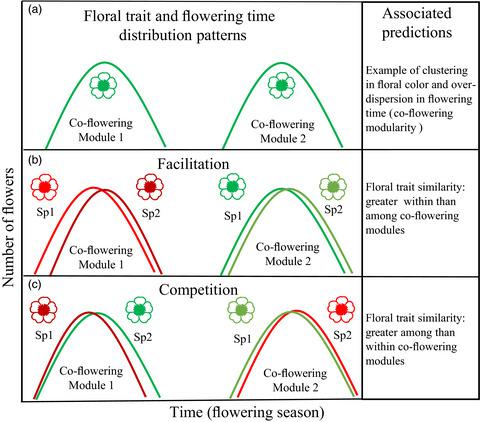Our official English website, www.x-mol.net, welcomes your
feedback! (Note: you will need to create a separate account there.)
Integrating floral trait and flowering time distribution patterns help reveal a more dynamic nature of co‐flowering community assembly processes
Journal of Ecology ( IF 5.3 ) Pub Date : 2020-08-09 , DOI: 10.1111/1365-2745.13486 Cristopher Albor 1 , Gerardo Arceo‐Gómez 2 , Víctor Parra‐Tabla 1
中文翻译:

整合花性状和开花时间分布模式有助于揭示共同开花社区集会过程的更动态本质
更新日期:2020-08-09
Journal of Ecology ( IF 5.3 ) Pub Date : 2020-08-09 , DOI: 10.1111/1365-2745.13486 Cristopher Albor 1 , Gerardo Arceo‐Gómez 2 , Víctor Parra‐Tabla 1
Affiliation

|
- Species' floral traits and flowering times are known to be the major drivers of pollinator‐mediated plant–plant interactions in diverse co‐flowering communities. However, their simultaneous role in mediating plant community assembly and plant–pollinator interactions is still poorly understood. Since not all species flower at the same time, inference of facilitative and competitive interactions based on floral trait distribution patterns should account for fine phenological structure (intensity of flowering overlap) within co‐flowering communities. Such an approach may also help reveal the simultaneous action of competitive and facilitative interactions in structuring co‐flowering communities.
- Here we used modularity within a co‐flowering network context, as a novel approach to detect convergent and/or over‐dispersed patterns in floral trait distribution and pollinator sharing. Specifically, we evaluate differences in floral trait and pollinator distribution patterns within (high temporal flowering overlap) and among co‐flowering modules (low temporal flowering overlap). We further evaluate the consistency of observed floral trait and pollinator sharing distribution patterns across space (three geographical regions) and time (dry and rainy seasons).
- We found that floral trait similarity was significantly higher in plant species within co‐flowering modules than in species among them. This suggests pollinator facilitation may lead to floral trait convergence, but only within co‐flowering modules. However, our results also revealed seasonal and spatial shifts in the underlying interactions (facilitation or competition) driving co‐flowering assembly, suggesting that the prevalent dominant interactions are not static.
- Synthesis. Overall, we provide strong evidence showing that the use of flowering time and floral trait distribution alone may be insufficient to fully uncover the role of pollinator‐mediated interactions in community assembly. Integrating this information along with patterns of pollinator sharing will greatly help reveal the simultaneous action of facilitative and competitive pollinator‐mediated interactions in co‐flowering communities. The spatial and temporal variation in flowering and trait distribution patterns observed further emphasize the importance of adopting a more dynamic view of community assembly processes.
中文翻译:

整合花性状和开花时间分布模式有助于揭示共同开花社区集会过程的更动态本质
- 众所周知,物种的花性状和开花时间是授粉媒介介导的植物在多种共同开花社区中相互作用的主要驱动力。然而,它们在调解植物群落装配和植物-授粉媒介相互作用中的同时作用仍知之甚少。由于并非所有物种都同时开花,因此基于花性状分布模式的促进性和竞争性相互作用推论应解释共同开花群落中的优良物候结构(开花重叠强度)。这种方法也可能有助于揭示竞争性和促进性互动在构建共同开花社区中的同时作用。
- 在这里,我们在共花网络环境中使用了模块化,将其作为一种检测花性状分布和授粉媒介共享中趋同和/或过度分散模式的新颖方法。具体来说,我们评估(高时间开花重叠)内和共花模块之间(低时间开花重叠)花性状和传粉媒介分布模式的差异。我们进一步评估了观察到的花卉特征和授粉媒介在空间(三个地理区域)和时间(干旱和雨季)之间共享分布模式的一致性。
- 我们发现,在共同开花模块内的植物物种中,花卉性状相似性明显高于其中的物种。这表明传粉媒介的促进可能导致花性状趋同,但仅在共花模块内。然而,我们的研究结果还揭示了推动共同开花的潜在相互作用(促进或竞争)的季节性和空间变化,这表明普遍的主导相互作用不是静态的。
- 综合。总体而言,我们提供了有力的证据,表明仅使用开花时间和花性状分布可能不足以充分揭示授粉媒介介导的相互作用在群落装配中的作用。将这些信息与传粉媒介共享模式整合在一起,将极大地帮助揭示共同开花社区中传粉媒介介导的促进性和竞争性互动的同时作用。观察到的开花和性状分布模式的时空变化进一步强调了采用更加动态的社区集会过程的重要性。









































 京公网安备 11010802027423号
京公网安备 11010802027423号